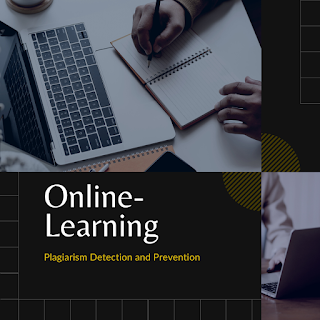·
What plagiarism detection software is available
to online instructors?
There are a few plagiarism detection software
available to online instructors. Most of them are paid software but there are
some free services available, although the checker may not be as thorough on
the free versions. I will list a few here.
· Turnitin: Measures the originality of student
work and provides reports. Can be used with most LMS systems. iThenticate is a
Turnitin product.
· Duplichecker: Offers free and paid tools which
include the ability to test documents, images, webpages, and paper paraphrasing
for plagiarism and grammar.
· Plagiarism Checker X: Offers and free and paid
version. Allows for testing of documents and web pages.
·
How can the design of assessments help prevent
academic dishonesty?
Assignments can be designed to test what
students know and help them to solve problems instead of just regurgitating
information. Dr. Palloff (2010) suggests creating collaborative assessments to
discourage cheating because “assessments should mirror real-life situation”
·
What facilitation strategies do you propose to
use as a current or future online instructor?
I do not plan to be an online instructor now or
in the future. However, if I was, I would structure my courses to be
collaborative with group assignments and open-book or essay assessments. I
would plan for the assessment to be the result of a course-long project with
checkpoints that allow me to see how the learners are taking in the
information.
·
What additional considerations for online
teaching should be made to help detect or prevent cheating and plagiarism?
I think that as technology grows, there will be
more AI software tools that will help not only instructors to check for plagiarism
but to help students with plagiarism as they write. We already see some of this
with grammar checkers but that could easily be expanded to include plagiarism
checking.
The information this week was helpful to me as a
student. I gathered examples of what may be considered cheating that I did not
know such as using my own papers from previous courses without quoting (myself)
could be considered cheating. I find that to be ridiculous because I can’t
steal from myself, however, I am aware of it now. Heaven forbid I have the same
thought more than once in my life while studying the same material multiple
years, gee willikers how could that happen? I also don’t plan to implement instructional
strategies in the future because that is not in my line of work as I don’t plan
to be an instructor or ISD.
References
Betts, K., Riccobono, M., & Welsh, B. (2013).
INTRODUCTION TO THE SPECIAL SECTION ON INTEGRATING ACCESSIBILITY INTO ONLINE
LEARNING. Journal of Asynchronous Learning Networks, 17(3), 1-5.
Harte, P., & Khaleel, F. (2021,
February 3). Designing online assessment to prevent academic misconduct.
Retrieved from The Campus:
https://www.timeshighereducation.com/campus/designing-online-assessment-prevent-academic-misconduct
Plagiarism and cheating (2010). [Motion Picture].

Hi, Jasmine! I am totally with you on the copying yourself thing! I know now I need to just be more cognizant of what I'm doing when it comes to that! I found a research paper based out of Iran in regards to plagiarism and there were some interesting points. One was that "many students and even professors have a very poor English language skill. Therefore, they tend to use the clauses used in other papers, which are easier for them to understand" (Abbasi, et. al, 2020). I don't even try to translate something not in my native language so I give huge props to those that do! I definitely think that falls into the contingencies of plagiarism of intent. Obviously, those students are not intended to plagiarize, but due to language constraints, they may do it inadvertently. I, like you, feel like there is so much nuance to plagiarism that it could be an entire course all on its own!
ReplyDeleteAbbasi, P., Ypusefi-Labani, J., Jalali, A., Ziapour, A., & Nouri, P. (2020). Causes of the plagiarism: A grounded theory study. Nursing Ethics, 28, 969733020945753. https://doi.org/10.1177/0969733020945753